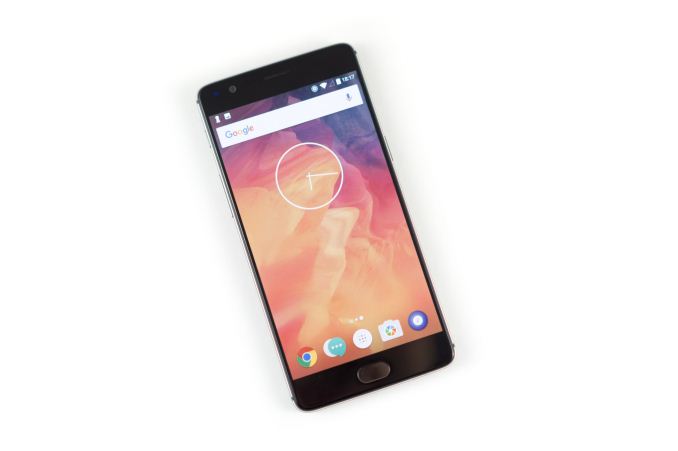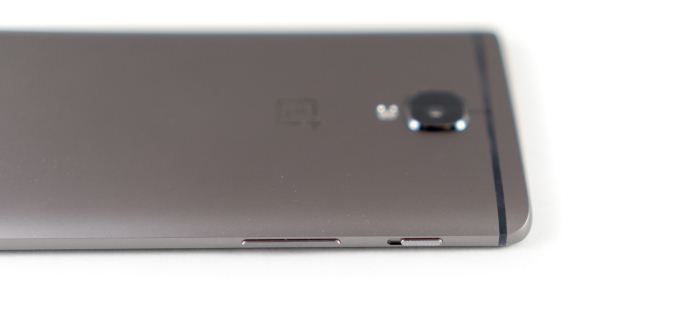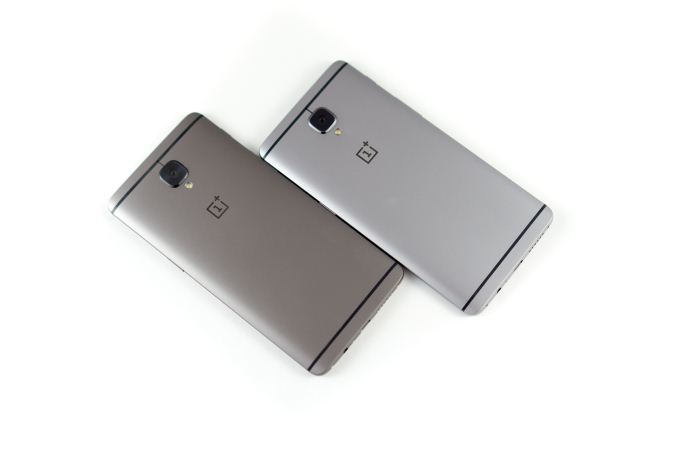The OnePlus 3T Review
by Brandon Chester on November 28, 2016 10:30 AM EST- Posted in
- Smartphones
- OnePlus
- OnePlus 3T

Back in June, OnePlus launched their new flagship smartphone, the OnePlus 3. I've had an interesting relationship with the OnePlus 3 due to certain decisions that were made regarding its display and some parts of the operating system before the phone initially launched. Since that time, OnePlus has made significant improvements to both of these aspects, and in my follow up piece I concluded that the OnePlus 3 should be considered by all smartphone buyers, even ones who were ready to pay $700 or $800 for a flagship phone from another company.
Earlier this month, OnePlus surprised a number of people in the Android community by launching a successor to the OnePlus 3. This move isn't in line with the yearly cadence that we've come to expect for their smartphones, which makes it all the more interesting. The name of this new phone is the OnePlus 3T, and based on that name one can already see that it represents an evolution of the OnePlus 3 rather than a revolutionary upgrade. As the OnePlus 3's successor, the OnePlus 3T simply serves to update certain aspects of the phone's hardware in order to take advantage of technology improvements that have been made available since the OnePlus 3 was originally developed and released.
This review focuses on the aspects of the OnePlus 3T that differ from its predecessor. Because of that, I recommend reading over my review of the OnePlus 3 if you're interested in other aspects of the phone like the camera quality. Before moving on, I've collected all the specifications for the OnePlus 3 and 3T in the chart below to make it clear which parts have changed and which have remained the same.
| OnePlus 3 | OnePlus 3T | ||
| SoC | Qualcomm Snapdragon 820 2 x 2.15GHz Kryo 2 x 1.6GHz Kryo 624MHz Adreno 530 |
Qualcomm Snapdragon 821 2 x 2.35GHz Kryo 2 x 1.6GHz Kryo 653MHz Adreno 530 |
|
| RAM | 6GB LPDDR4 | ||
| Display | 5.5" 1920 x 1080 PenTile AMOLED | ||
| Size / Mass | 152.7 x 74.7 x 7.35mm, 158g | ||
| Battery | 3000 mAh | 3400 mAh | |
| Rear Camera | 16MP 1.1 μm Sony IMX298, f/2.0, OIS | ||
| Front Camera | 8MP 1.4 μm Sony IMX179, f/2.0 |
16MP 1.0 µm Samsung S5K3P8, f/2.0 |
|
| Storage | 64GB UFS 2.0 | 64/128GB UFS 2.0 | |
| I/O | USB 2.0 Type-C connector, 3.5mm audio | ||
| Connectivity | 1x1 802.11a/b/g/n/ac + BT 4.2, USB-C, GPS/GNSS | ||
| Software | Android 6.0.1 OxygenOS 3.2.8 |
Android 6.0.1 OxygenOS 3.5.1 |
|
| Price | 64GB 399 USD |
64GB 439 USD 439 EUR 399 GBP 599 CAD |
128GB 479 USD 479 EUR 439 GBP 639 CAD |
For the most part, the OnePlus 3T is the same as the OnePlus 3. The size and mass are both the same, the display is the same, the rear-camera is the same, and the connectivity is the same. Internally OnePlus has made some changes to certain components. The most obvious change is the new SoC, with Snapdragon 820 being replaced with a faster Snapdragon 821 chip, while the RAM remains a healthy 6GB of LPDDR4. The battery capacity has also increased from 3000mAh to 3400mAh, which is a 13% increase without any change in the size or mass of the phone. The last major change is the new front-facing camera, which has moved from the 8MP 1.4µm Sony sensor on the OnePlus 3 to a 16MP 1.0µm Samsung sensor. In addition to the changes across all models, OnePlus has also introduced a 128GB SKU for users who need more storage. All of these changes also come at a higher price, with the 64GB model starting at $439, up from $399, and the 128GB model coming in at $479.
Design
As far as its design goes, the OnePlus 3T is mostly unchanged from its predecessor. I'm quite a fan of the OnePlus 3's design, so I don't feel that there was any need to change it significantly. The relatively thin body and the tapered back design make it far more usable with one hand than other 5.5" smartphones like the Pixel XL or the Moto G4. Being made from a single piece of aluminum, the chassis has none of the seams that the OnePlus One and OnePlus 2 had, and it feels incredibly solid in the hand. Unlike certain other vendors, OnePlus has also taken the time to actually align the various ports and buttons on the sides of the chassis instead of placing them wherever is convenient without any regard for aesthetics or usability.
Beyond the purely physical aspects of the design, I think OnePlus's design decisions regarding the placement of controls also makes the phone easier to use than competing devices. Having been using the OnePlus 3 since launch, I can say with certainty that OnePlus is on the right side of history by putting the volume rocker on the left side of the phone along with a physical switch for toggling notification settings. I also really appreciate having capacitive navigation buttons instead of wasting space on the display with on-screen buttons sitting above a bottom bezel that could easily fit physical ones. Putting the fingerprint scanner on the front of the phone as part of the home button also makes it simple to turn on and unlock the phone, even if it's sitting on a table.
The only aspect of the design that has changed from the OnePlus 3 is the color of the phone. The OnePlus 3 was originally available in a standard silver aluminum finish and later came in a gold finish, while the OnePlus 3T comes in a gunmetal grey finish and a gold finish from the start. The gold finish is only available in a 64GB capacity, while the gunmetal has both a 64GB and a 128GB version. For this review the 128GB gunmetal model was sampled, and I think it's a nice look for the phone. It's certainly not as dark as Apple's black iPhone 7 finish, but it's visibly darker than the OnePlus 3's aluminum and helps to distinguish between the two. I wouldn't have minded if OnePlus had also kept the standard silver finish available, as I think it looked rather nice as well, but I don't think the gunmetal is such a dramatic change in color that users will be bothered by silver being unavailable.












104 Comments
View All Comments
jaspreet - Tuesday, November 29, 2016 - link
My office collegue got a pixel xl and has been showing off as to how good it is . I will be sending him this article which clearly shows that pixel xl is a much much poorer phone than a almost half priced One Plus 3T . Time to shut him up :)amdwilliam1985 - Tuesday, November 29, 2016 - link
Yeah, for some reason Pixel XL does poorer on benchmarks, but in real life(where it actually matters) Pixel XL rules. Too bad we can't read about UI/UX in reviews, you have to use the phone to actually get/know the experience.jaspreet - Tuesday, November 29, 2016 - link
Not sure what you mean , but real life and all are up in the air things . You need to back it up with numbers to convince people to go for the phone . I dont see anyone sane going for pixel which performs poorly as shown here, compared to the very good one plus 3T as an android phone priced half . To me it is funny that despite being such a poor phone some sites have raved about it which was irritating . I think Anandtech has show Pixel its rightful place ie at the bottom . Well Done.ithehappy - Tuesday, November 29, 2016 - link
You do realise that the camera is pretty bad on the OP3 right?arayoflight - Tuesday, November 29, 2016 - link
The read and write speeds are increased due to F2FS file system instead of EXT4. Oneplus 3 with Oxygen OS 3.5.6 posts the same numbers.Here are the results from my Oneplus 3 using F2FS instead of EXT4( 1 thread, 4KB random, 256KB seq)
https://goo.gl/photos/Mm8xjr5pMkwsRJuR8
UtilityMax - Tuesday, November 29, 2016 - link
Oneplus 3T still performs like a flagship killer phone while undercutting everyone else in price. However, I feel like Oneplus no longer offers the killer value it had when it introduced Oneplus One for only 300USD (for 16GB version) two years ago. Sure, the specs have improved since then, but aren't memory storage and cores supposed to get cheaper with time? We see a 50% price hike over the original Oneplus One, and the 3T no longer feels like a steal. It's still has a very good value though.Meteor2 - Tuesday, November 29, 2016 - link
Why give away your products when you don't have to. Intel found that out with cheap Atoms for tablets. Sad times for us though.Lolimaster - Tuesday, November 29, 2016 - link
We really need 1440 and 1080p RGB AMOLED.mkhadi1 - Tuesday, November 29, 2016 - link
Is there a LG V20 review in the works?BenSkywalker - Tuesday, November 29, 2016 - link
Are you actively trying to lose credibility on your display analysis?Why not argue that LCDs have superior contrast to OLEDs- you will find that outside of yourself, it has as much support as your stance on off angle viewing issues. The point is measurable- go ahead, try it. Your dE results will tell you what every other person in the world can easily see- this is *NOT* debatable. For the record- the OnePlusOne becomes washed out to the point of being unreadable before the color shift on the OnePlusThree is close to severe- while still being usable. That isn't hypothetical, they are sitting here side by side.
You can measure it for yourself. If you find something other then what I am saying it would be groundbreaking and shake up display analysis and observations around the world, so why won't you do it?